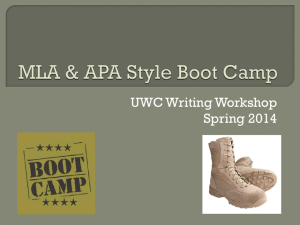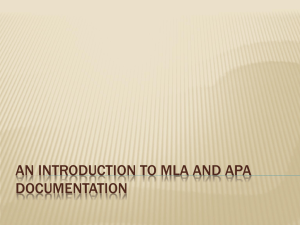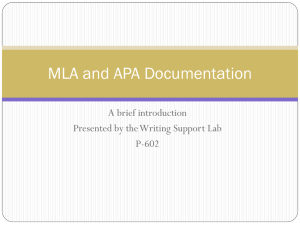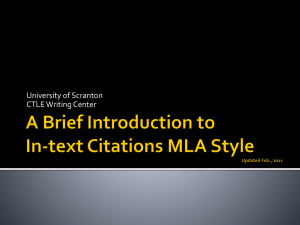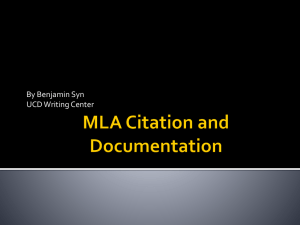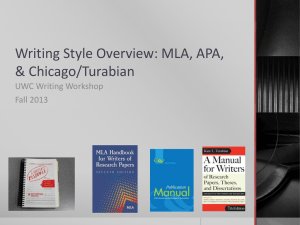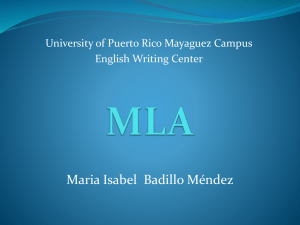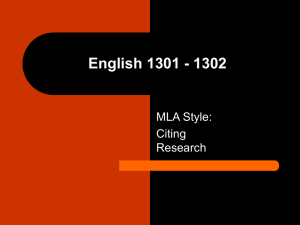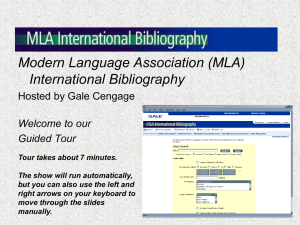Citations 2014 - Ivy Tech Community College
advertisement
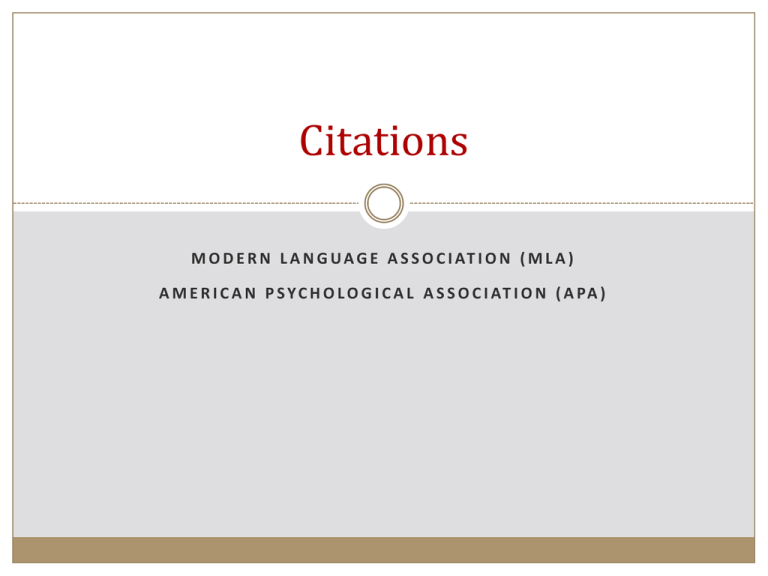
Citations M O D E R N L A N G U A G E A S S O C I AT I O N ( M L A ) A M E R I C A N P S Y C H O L O G I C A L A S S O C I AT I O N ( A PA ) General Citation Information Citation: An act of quoting. (“Citation”) When preparing to write a document with an assigned topic, it is assumed that several information outlets will be researched while gathering information. Take careful notes during the research process. Keep track of all sources that directly influence the information used in the document. To avoid plagiarism, it is imperative to give recognition to the individuals from whom information was borrowed. Known as citing sources, each source must be listed at the end of the document. Plagiarize: to steal and pass off the ideas or words of another as one’s own. (“Plagiarize”) General Citation Information Not only is it important to cite sources, but also to do so in the correct manner. Two important formats used are: Modern Language Association (MLA) American Psychological Association (APA) It is at the instructor’s discretion to decide which format to use. Always check with the instructor first to see which format should be used. MLA and APA Basic Knowledge What is MLA? MLA is a standardized format for written communication that focuses on page layout, stylistic technicalities, and citing sources in a document. It is used in the humanities field in subjects such as art, literature, and history, and is primarily directed toward an audience of graduate students, academic scholars, professors, professional writers, and editors. What is APA? APA is a standardized format for written communication that focuses on the content organization, writing style, and references in a document. It is used in the fields of social and natural sciences, and is found in use in term papers, research reports, case studies, and theoretical articles, among others. Differences of MLA and APA Modern Language Association (MLA) American Psychological Association (APA) Used for humanities: art, literature, history Used in social and natural sciences Requires in-text citations (author’s last name and page) for quotations, paraphrases, or summaries of material from print sources Requires in-text citations (author’s last name, year, and page) for quotations, paraphrasing, and references to specific passages (pages not required for general references) Alphabetizes sources on a double-spaced Works Cited page Alphabetizes sources on a double-spaced References page Emphasizes the author and the title of publication by placing them near the beginning of the entry Emphasizes the author and the date of the publication by placing them near the beginning of the entry Follows conventional capitalization rules for article titles Does not capitalize all words in book and article titles, but does capitalize names of magazines and journals Prints full first names Initializes the authors’ first names Abbreviates months (except for May, June, and July) Does not abbreviate months Requires states in publication location, except for the following U.S. cities: Baltimore, Boston, Chicago, Los Angeles, New York, Philadelphia, San Francisco. (There are also some international cities that may be listed without country.) (If the publisher is a university and the name of the state is included in the name of the university, do not repeat the name in the publisher location.) Does not require states to be included in publication location (Ivy Tech, 2008, p. 10) Overview of In-Text Citations In-text citations are found at the end of direct quotations and paragraphs where information was borrowed or otherwise paraphrased. In-text citations guide the reader to find more information about the source used. In MLA, full citation information must be placed at the end of the document on a Works Cited page. In APA, full citation information must be placed at the end of the document on a References page. Providing a page number helps to direct the reader to the exact location of the borrowed information, should they consult it. MLA In-Text Citations MLA uses the author-page citation system. To insert a MLA formatted in-text citation, include the author’s last name and the page number from the original text. The author’s name may appear in the sentence or inside the parentheses. The page number, line number, or paragraph number should always appear inside the parentheses. When using the same cite multiple times, do not include the author’s name after the first in-text citation, only page number. … it was discovered that the information was logical (Smith 24). Smith discovered that the information was logical (24). MLA In-Text Citations When citing a direct quotation, provide the author’s last name and specific page citation. “The case studies proved that the theory was accurate” (Smith 24). When citing two or more sources in the same paragraph, arrange in-text citations in alphabetical order as they would be found in the Works Cited list, separated by a semicolon. Multiple studies (Johnson 23; Smith 43; Wilson 60) were conducted. APA In-Text Citations APA uses the author-date citation system. To insert an APA formatted in-text citation, include the author’s last name and the text’s publication year. … it was discovered that the information was logical (Smith, 2003). In 2003, Smith discovered that the information was logical. Smith (2003) discovered that the information was logical. When citing a direct quotation, also include the page number or specific location of the phrase from the original text. “The case studies proved that the theory was accurate” (Smith, 2003, p. 24). APA In-Text Citations When citing two or more sources in the same paragraph, insert the author’s last name and the text’s publication year. Arrange in-text citations alphabetically as they would be found the Reference list. Multiple case studies (Johnson, 2001; Smith, 2003) were conducted. MLA Endnotes/APA Footnotes Endnotes and footnotes are brief sentences of additional information. While MLA and APA discourage the use of endnotes and footnotes, it may be a requirement. To insert an endnote or footnote, a superscript number is placed at the end of a sentence which will be elaborated, following the punctuation mark. In MLA, endnotes are placed on a separate sheet before the Works Cited sheet.1 In APA, footnotes are placed at the bottom of the same sheet or on a separate sheet after the References sheet.2 MLA Endnotes/APA Footnotes Specific guidelines must be followed to format the endnote or footnote sheet. Those guidelines are: Center the word “Notes” (unformatted, omitting quotation marks) at the top of the page for MLA formatting Center the word “Footnotes” (unformatted, omitting quotation marks) at the top of the page for APA formatting The first line should be indented five character spaces, each additional line should be flush with the left margin Double space all sentences Place a period and space after each endnote number for MLA Use a superscript number and space for APA (no period) MLA Endnotes/APA Footnotes Notes 1. This is how an endnote for a MLA formatted paper should appear on a Notes sheet. Please remember to keep all endnotes brief, as they can be distracting and costly. 2. This is how an endnote for a MLA formatted paper should appear on a Notes sheet. Please remember to keep all endnotes brief, as they can be distracting and costly. Footnotes 1 This is how a footnote for an APA formatted paper should appear on a Footnotes sheet. Please remember to keep all footnotes brief, as they can be distracting and costly. 2 This is how a footnote for an APA formatted paper should appear on a Footnotes sheet. Please remember to keep all footnotes brief, as they can be distracting and costly. MLA Works Cited Page MLA formatting calls for a Works Cited page on a separate sheet at the end of a document. All entries on the Works Cited page must directly correspond to the work cited in your main text. Specific guidelines must be followed to format the Works Cited sheet. Those guidelines are: One inch margins on all sides Last name and page number in a running header MLA recommends using a 12pt. legible font Center the words “Works Cited” (unformatted, omitting quotation marks) at the top of the page Use double line spacing Use a hanging indent paragraph style (first line is aligned flush with left margin but additional lines are indented five character spaces) Entries should appear in alphabetical order Capitalize all major words of titles and subtitles, italicize titles of longer works MLA Works Cited Page Works Cited (Author. “Title of Article.” Title of Journal Volume.Issue (Year): pages. Medium of publication.) Johnson, George. “Do Case Studies by Health Professionals Provide Enough Information for Theories to be Proven?” Health Professional Journal 10.5 (2012) : 45-55. Print. (Last name, First name. Title of Book. City of Publication: Publisher, Year of Publication. Medium of publication.) Smith, John. Proven Logical Theories and Beyond: Real Life Case Studies. Boston: Efficient Publishing Company of Greater Massachusetts, 2012. Print. (Editor, author. Name of Site. Version Number. Name of Institution, date of creation. Medium of publication. Date of access. URL *if required*) Wilson, David. Case Studies and Theories. Indiana University, May 2012. Web. May 16, 2012. <http://www.casestudiestheories.iu.edu> APA Reference Page APA formatting calls for a References page on a separate sheet at the end of the document. All entries in the References page must directly correspond to the work cited in your main text. Specific guidelines should be followed to format the References page. Those guidelines are: One inch margins on all sides APA recommends using Times New Roman 12pt. Font Center the word “References” at the top of the page, unformatted Use double line spacing Use the hanging indent paragraph style (first line is aligned flush with left margin but additional lines are indented five character spaces) Entries should appear in alphabetical order Capitalize all major words of journal titles Only capitalize first word of title and first word of subtitle for books and articles, italicize titles of longer works such as books and journals APA Reference Page References (Author, A. A. (Year). Title of article. Title of Journal, volume number(issue number), pages.) Johnson, George. (2012). Do case studies by health professionals provide enough information for theories to be proven? Health Professional Journal, 10(5), 45-55. (Author, A. A. (Year of publication). Title of book: Capital letter also or subtitle. Location: Publisher.) Smith, John. (2012) Proven logical theories and beyond: Real life case studies. Boston, MA: Efficient Publishing Company of Greater Massachusetts. (Author, A. A. (Date of publication). Title of document. Retrieved from http://Web address) Wilson, David. (May 2012). Case studies and theories. Retrieved from http://www.casestudiestheories.iu.edu Citation Builder Ivy Tech Blackboard offers an automatic citation building tool. To use the automatic builder: Log into Blackboard (http://online.ivytech.edu) Click the Library tab Click on Richmond under the Regional Libraries section on left side Click on Help Click on Citing Sources Click on NoodleTools Register and sign in Click on Create a New Project Decide which format to use and name your project Click on Create Project Click the Bibliography tab at the top Create your citations References References American Psychological Association. (2012). The basics of apa style. Retrieved from http://www.apastyle.org Angeli, E. (2012, May 9). General format. Retrieved from http://owl.english.purdue.edu/owl/resource/560/01/ Citation. (n.d.). Retrieved from Merriam-Webster online: http://www.merriam-webster.com/dictionary/citation Ivy Tech. (2008) Ivy tech citation handbook: Citing sources with mla & apa. Retrieved from http://wwwcc.ivytech.edu/shared/shared_librstatewidecc/pdf-files/citationhandbooks/flibrary-apa-mla-citationhandbook.pdf Plagiarize. (n.d.). Retrieved from Merriam-Webster online: http://www.merriam-webster.com/dictionary/plagiarize Russell, T. A. (2012, May 9). Mla formatting and style guide. Retrieved from the purdue owl. purdue u writing lab: http://owl.english.purdue.edu/owl/resource/747/01/ Wikipedia. (2012, May 16). The mla style manual. Retrieved from http://en.wikipedia.org/wiki/the_mla_style_manual
